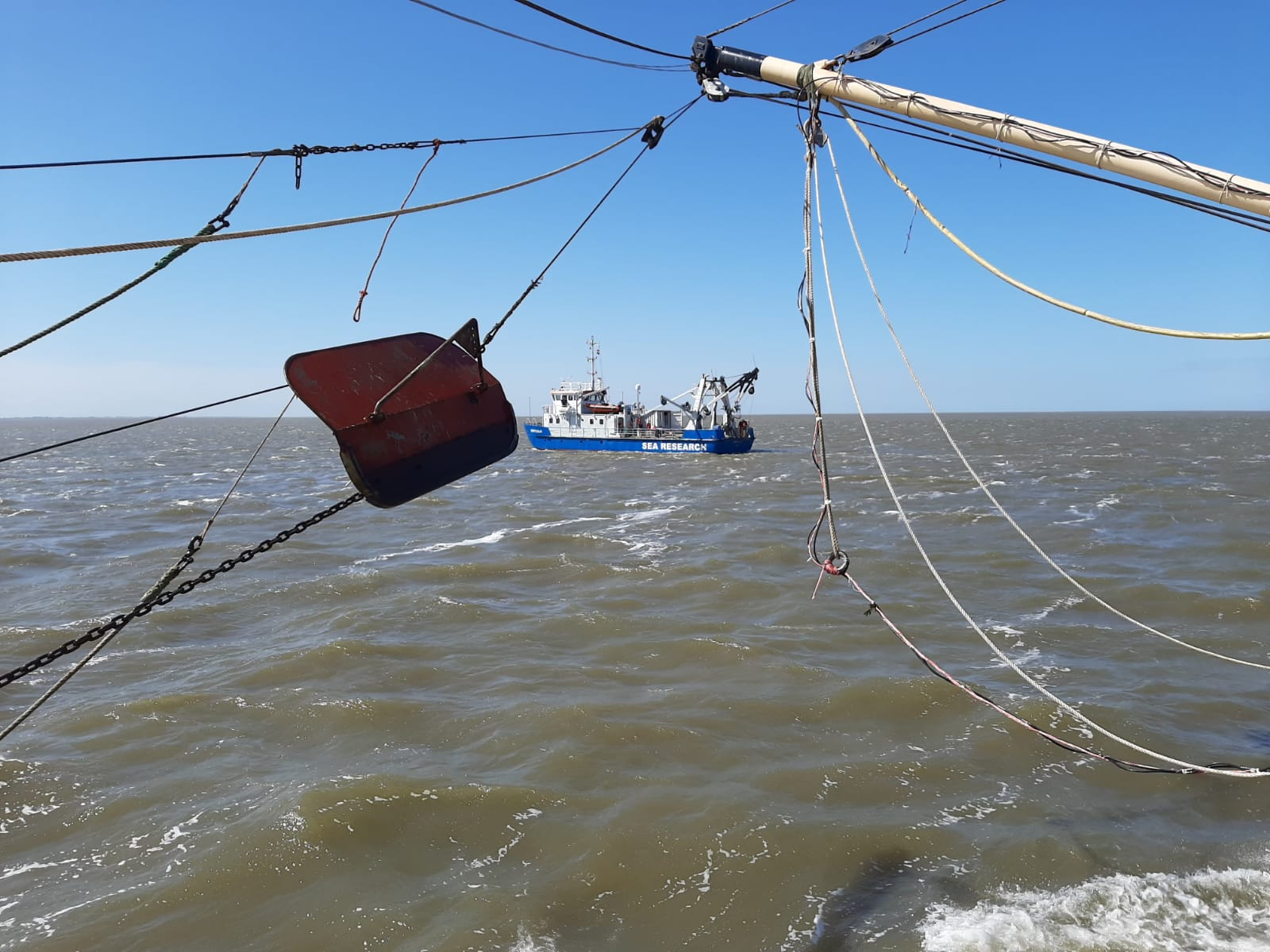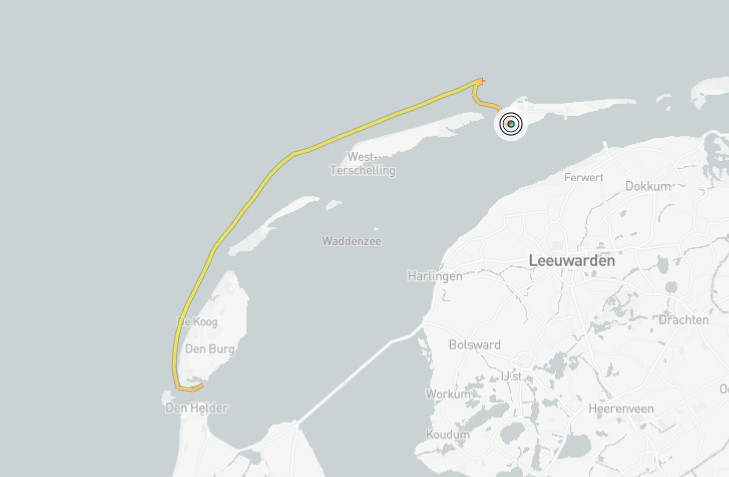Monday 9 May 2022
By Tjitske Kooistra
Our adventure started this morning with loading an amount of food on board that we didn’t believe we would be able to eat in five days. When the crew and the kitchen stores were complete, we set sail to Ameland. Usually, this involves navigating through channels in the Wadden Sea. Today however, the weather was on our side and we were able to pass by the North Sea coast of the islands. Despite the exceptionally calm weather, we still felt the sea; the Navicula is a flat ship that wobbles like a bathtub.
We arrived at the Ameland inlet halfway the afternoon and decided to take advantage of the good conditions by visiting an important, but often hard to reach measurement station: the location of the ebb-tidal delta nourishment itself. The nourishment was placed on the northwestern side of the inlet, where the largest waves normally break and the seafloor becomes treacherously shallow. Today however, the sea was calm and we measured just after high tide, with still ample water between us and the sea floor.

My fellow TRAILS-PhD Anna-Maartje de Boer (Wageningen University) is trying to trace sand grains by their luminescence signal: a signal that builds up through the presence of a low dose of naturally occurring radioactive radiation and is reset when the sand grain is exposed to light, so called “bleaching”. With this method, the nourishment sand could potentially be distinguished from local sand. But where and when is the sand exposed to enough light to “bleach”? To discover this, we measure the light levels under water; and not just part of the light spectrum, no, all wavelengths! We use a spectrometer, mounted on a frame. Together with measurements on water current, depth, salinity, sand and silt concentration by other instruments with cryptical names (CTD, OBS, ADV and ADCP), Anna-Maartje will construct a model for sand bleaching together with our TRAILS colleague Stuart Pearson (TU Delft). To inform this model, we measure all those parameters under a wide range of conditions. And we already notice large differences: during our previous cruise in February, just a few days after the great storm Eunice, little light penetrated the water. Today, we were surprised to still measure quite a lot of light at the sea floor at eight meters depth. Even though the water appears aquamarine because of an algal bloom, apparently this does not extinguish all light at depth. Curious if we will see the same tomorrow in the Wadden Sea!
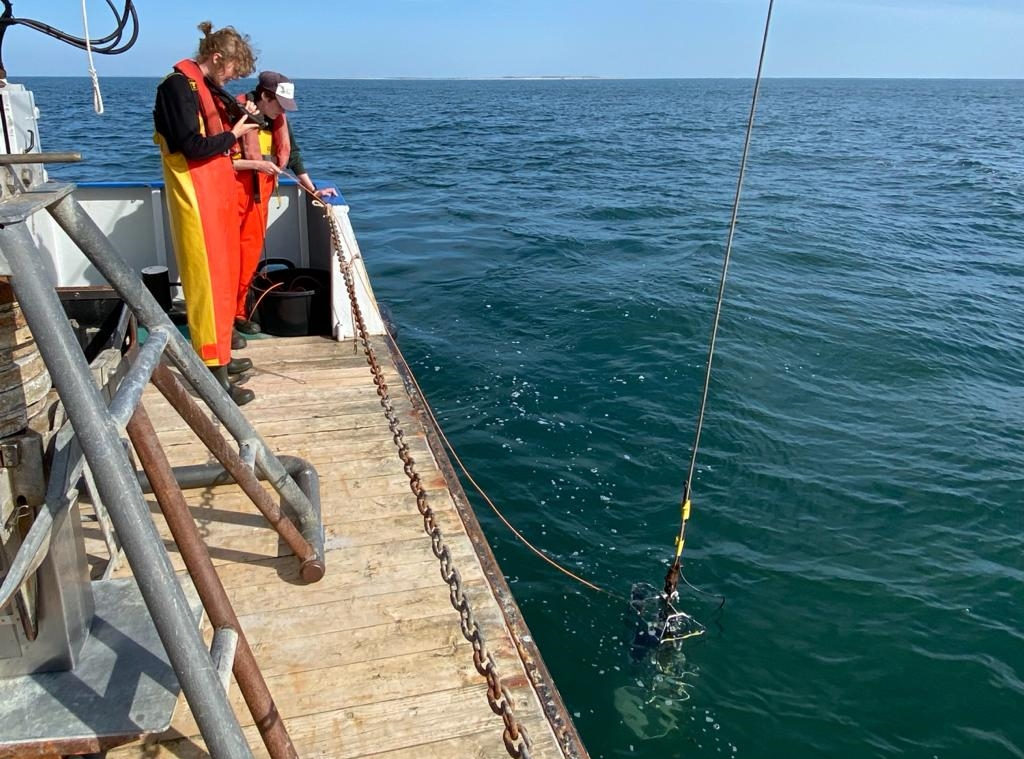
Tuesday 10 May 2022
By Tjitske Kooistra
“Ja!” … “Gereed!” (Yes! … Ready!). The two words of the day, according to captain Bram, who was driven close to crazy by hearing this on the radio the entire day. The “Ja” is Anna-Maartje, indicating that the measurement frame is at the right depth, the “Gereed” is Eric, telling that the measurement is finished and the frame can be lowered another half meter. In this way, we measured profiles of the entire water column at five locations across the inlet channel, just next to Ameland. We did this also at four phases of the tidal cycle: ebb, low tide, flood and high tide. Some rough math gives about 400 spectrum measurements, within 20 profiles. And just like yesterday, the water was very clear! Besides from the spectrometer, which still measured a tiny spec of light at the 16-meter deep sea floor, the difference became obvious during the filtering of the water samples.
On deck, the measurement frame is lowered by Anna-Maartje and Roan. Silke, Biem and Tjitske sample water with a pump . Video: Tjitske Kooistra.
We sample water from five different depths with a pump, separate the silt from the sand and coarse fraction, and pump the water through a filter. These filters will be weighed later to determine the suspended sand and silt concentrations. Silke Tas, a PhD candidate from TU Delft, who is helping us this week as a volunteer, appears to have a talent for processing the samples at top speed. Or was it the clear water that made the filtering go so fast? Whereas in February, filtering one sample could take almost half an hour because it was full of silt, today it was usually done in ten minutes. The filters did become a bit brown, presumably from algae, but they coloured much lighter than the ones from our last stormy cruise.
Silke’s speedy water filtering routine. Video: Silke Tas
Although it is satisfying to see the measured values appear on the screen immediately, and the first results are exciting, today’s measurement became a bit monotonous after a while. Besides, as a biologist, I am especially interested in the life on the sea floor. In the afternoon, we had some time between two measurements to start taking boxcore samples at the same locations where we measured the profiles. The conditions in the inlet channel are quite harsh for seafloor animals, so I’m interested in seeing what animals can live here and can tolerate being washed away or buried by sand. Tomorrow, more boxcoring is on the planning, if possible at the ebb-delta again. May the weather be in our favour!
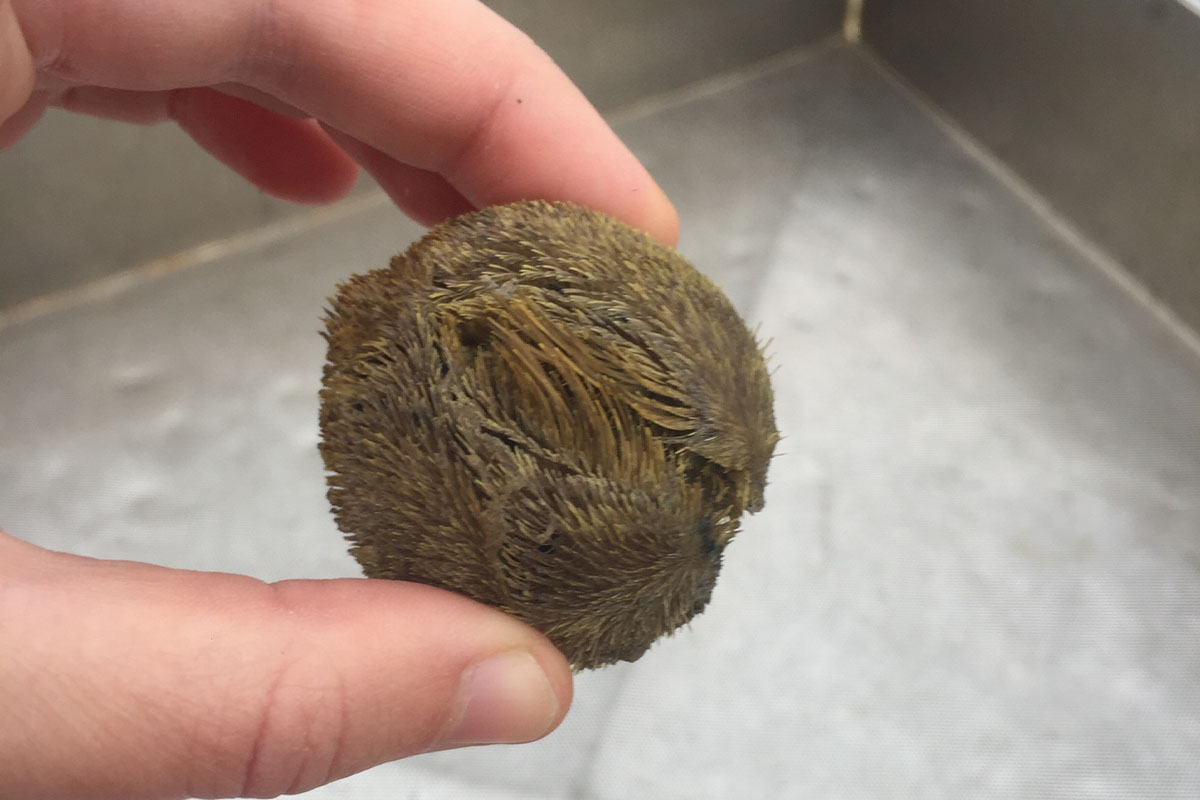
Wednesday 12 May 2022
By Tjitske Kooistra
We adopted a pet today. Her name is Sandy. Sandy is a heart urchin (“zeeklit”), a species of sea urchin that is common in the North Sea. They burrow in seafloor, especially on sandy locations, and can have a life span of 10 years. We hope our Sandy will survive at least until we are back on Texel, then she may have a chance for a star career at Ecomare.
This morning, the weather and waves allowed us to sail out to the ebb-tidal delta again, and we were able to take boxcore samples at most of our desired locations before lunch. These locations were also sampled prior to the nourishment, so they are most interesting to make a comparison over time. Furthermore, we expect that the nourishment sand travelled eastward, therefore we started with sampling northwest of Ameland. In the afternoon, we tried the locations that we expected to be difficult, because they would be too shallow according to the charts. Surprisingly, this was not the case everywhere; the ebb-tidal delta changes so fast that the charts can’t keep up
Boxcoring at the ebb-tidal delta.
At every location, we took two boxcore samples: one for a sand sample for luminescence tracing by Anna-Maartje, and one for benthos (sea floor animals) for me. For the luminescence sample, Anna-Maartje hammers a PVC tube into the core. It is very important that the sand is not exposed to light, because then the signal is reset. Therefore the core has to be big enough and stay whole. The samples are kept in the dark and will be analysed in the dark OSL lab at Wageningen University.
From the boxcores for benthos, I take pictures and a sediment sample for grain size composition, before we put it on a sieve table to wash out all the sand and mud. Everything that remains on the sieve after some washing is stored for further sorting. Back in the lab, I will separate the benthic animals from everything else, like shells, pieces of peat, clay and seaweed.
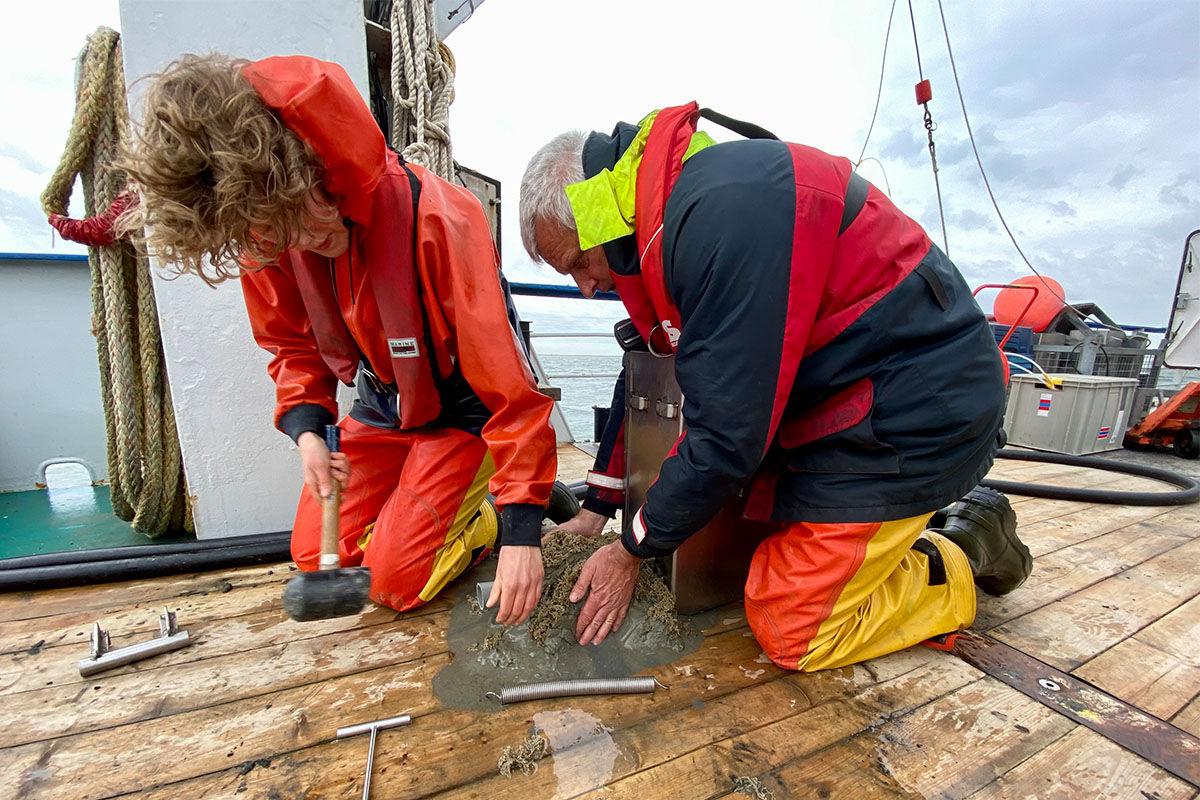
We found Sandy in one of the luminescence-boxcores. After sampling, the rest of the core is disposed. Thus, we decided to keep Sandy, potentially for display at Ecomare. Sandy is quite large for her species and it is fascinating to see how fast she can bury herself into the sand. With this burrowing, urchins mix the seabed, so called “bioturbation”. A next step in my research is looking at how heart urchins and other bioturbators mix the nourishment sand into the seabed or disperse it.
Besides heart urchins, the catch of the day included many catworms, a hermit crab, several bivalve species, such as the American razor clam, and even some fish (sandeels and a schar?, which we returned to the sea). Overall, it was a very successful day, with about 45 boxcores. Not bad, for the not yet so experienced boxcorers that we are!
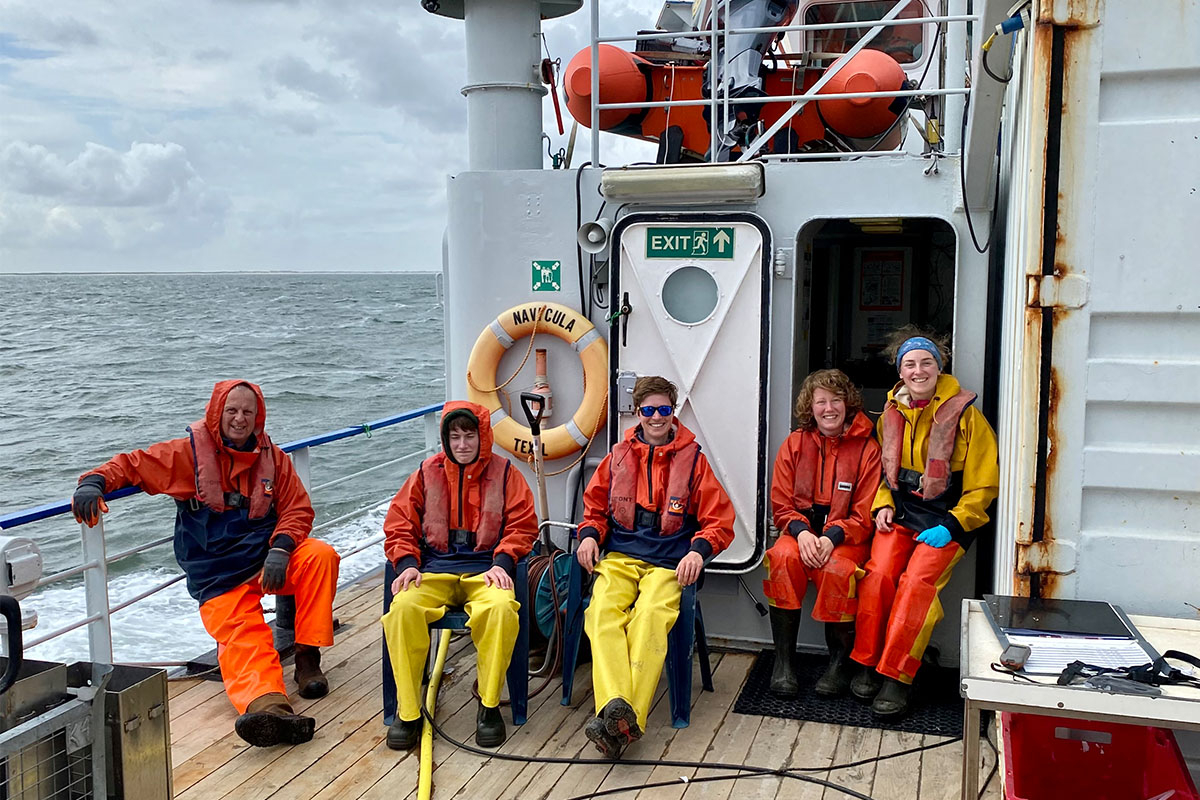
Thursday 12 May 2022
By Tjitske Kooistra
Flushing with a lot of water, while mixing with a scraper (“plamuurmes”), today we perfected our technique of sieving boxcore samples on the sieve table. Whereas at the ebb-tidal delta, we got sandy cores that melted as snow when flushing them, today our boxcores were full of clay, shells, peat and sometimes such coarse sand that is was almost rock. This required rigorous flushing, stirring and mixing, to reduce the sample to a workable size. Above that, we often had a queue of cores waiting to be sieved, since the sampling locations were close to each other.

Bringing the boxcorer on board (video: Tjitske Kooistra)
We made optimal use of our last sampling day to boxcore in the Wadden Sea: we sampled on transects across the main channel of the Borndiep, that connects the Ameland inlet with the Wadden Sea. Like everything in the Wadden Sea, this gully is constantly moving. On one side of the channel, sediment is eroded, while on the other side, sediment is deposited. I’m looking at which animals live on both sides and how they are adapted to all this movement of sediment. This could tell something about their sensitivity to sand nourishments, after all this is the area where we would expect the nourishment sand to end up first, if it enters the Wadden Sea. By comparing locations closer to the North Sea with locations into the Wadden Sea basin, we can see where the influence from each one ends and how they are connected to each other.
All this sediment movement and the strong tidal currents in these areas make it a not very comfortable place to live. We did indeed find less animals than could be expected in more calm areas or the mudflats, however there was still life. Some of the fun catches of today were a piece of peat full of false angelwings (Amerikaanse boormossel), a lot of large catworms again and a few Baltic tellins (small clams) deeper into the Wadden Sea. What was also interesting, especially for the geologists among us, was the other stuff that we find in the boxcores: at some locations a lot of peat, especially in the inlet many shells and coarse sand, and a lot of clay and some mud further into the Wadden Sea.
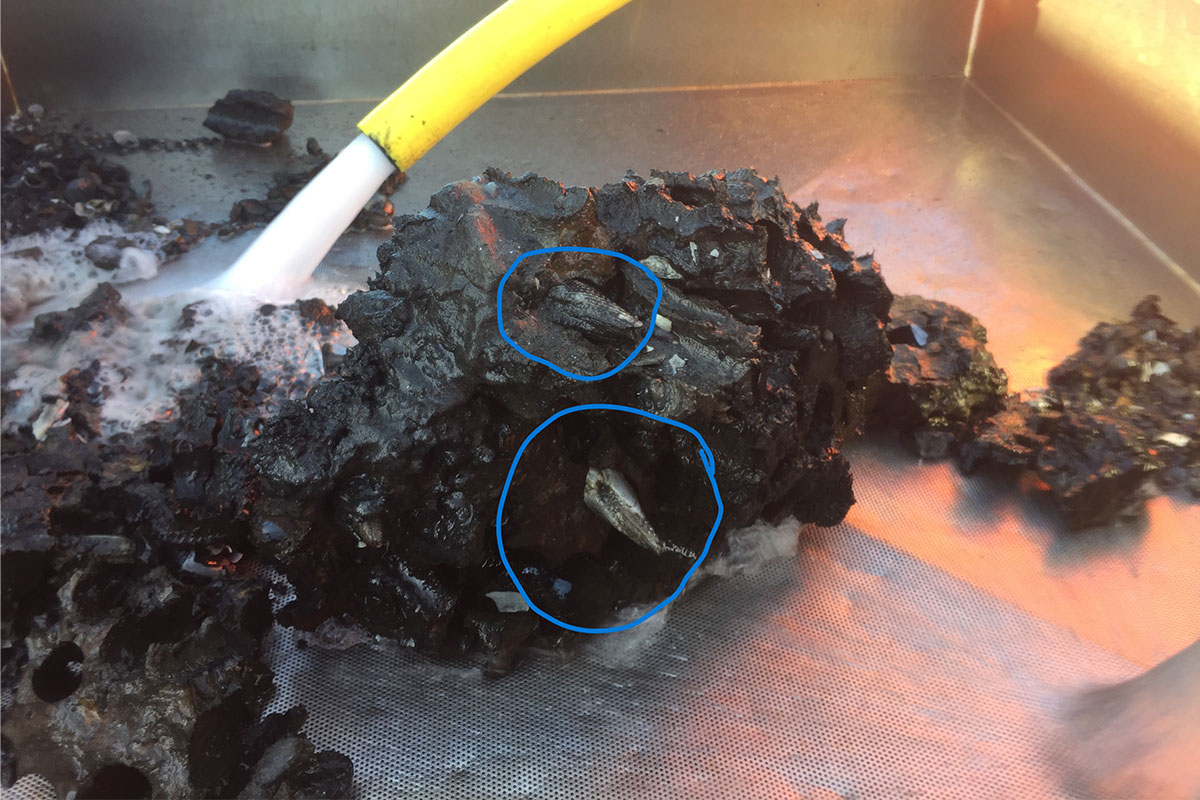
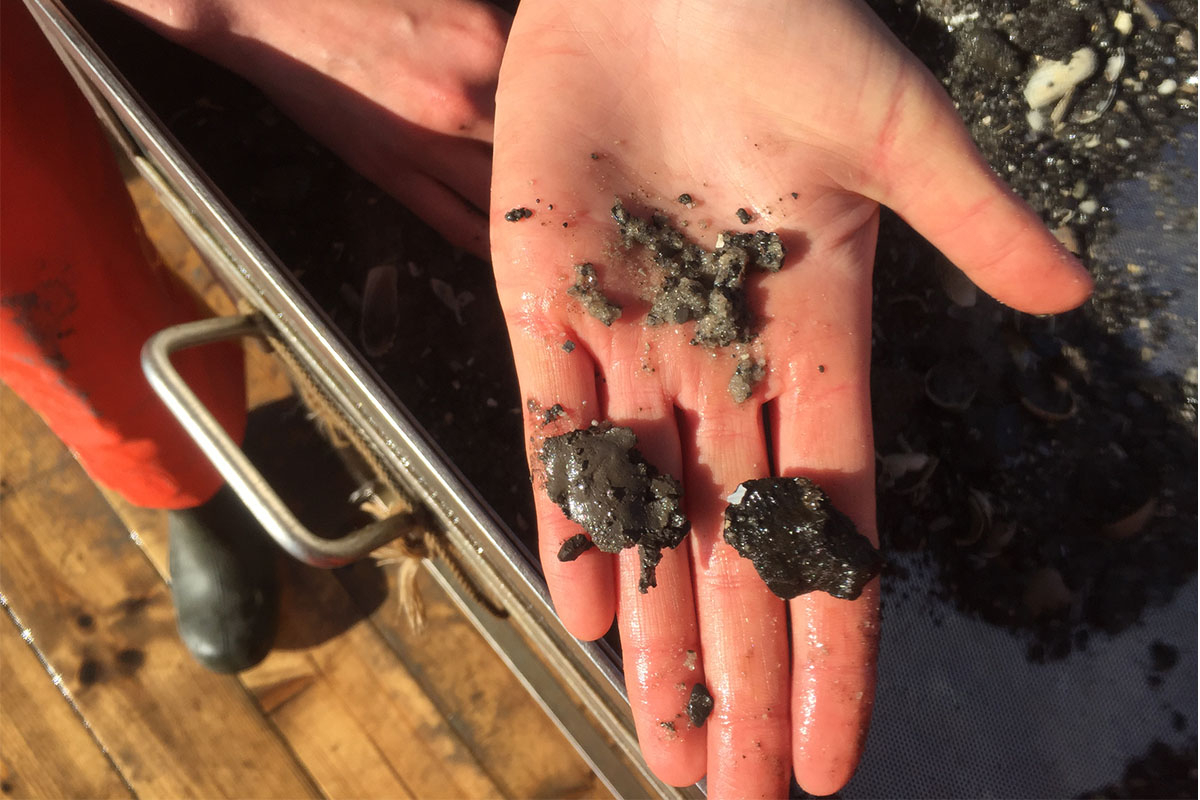
Halfway the ebb-tide this morning, we also saw our chance to measure a profile. We did this further into the Wadden Sea, a bit under Ameland and at the moment we expected the highest turbidity, to add to our range of conditions. Our expectations were true: Eric was almost surprised to say that he didn’t see any light anymore below two meters depth. Also the difference on the filters was crystal clear: they were almost clogged with silt and turned very brown.
When we finished the boxcore transects that were on our wish list, it was still just halfway the afternoon. Thankfully, the rest of the team was also enthusiastic to go on a bit longer, and we sampled a “bonus” boxcore transect in the inlet, a location we were not able to sample in February. This brings us at a total of 99 boxcores for this week, a great achievement considering we spent almost a full day measuring profiles as well. Happy and satisfied!
